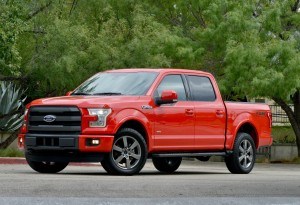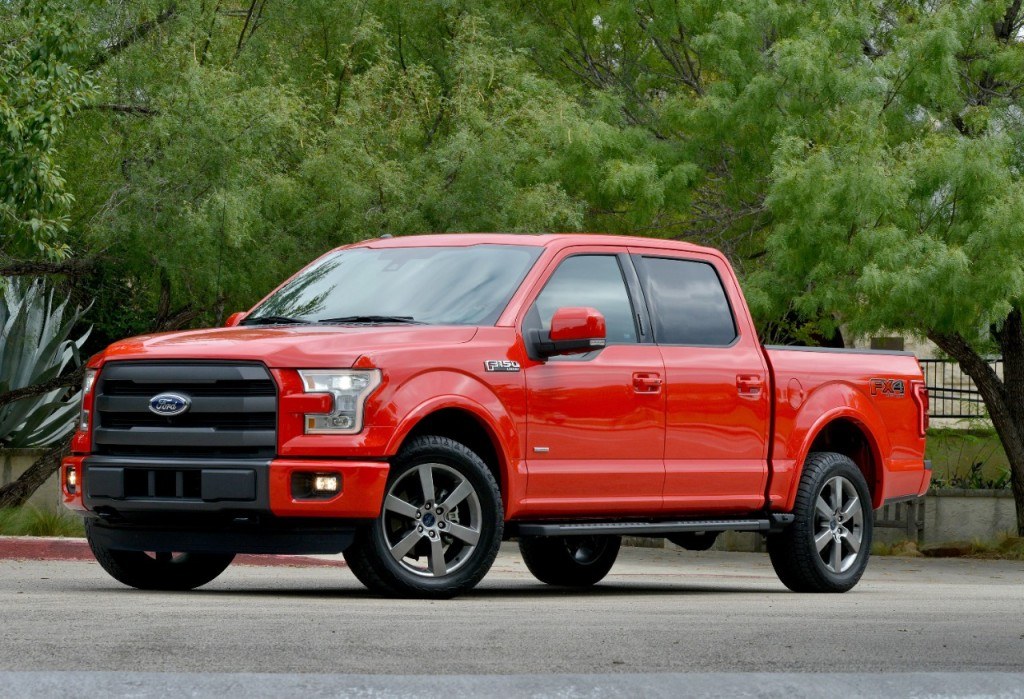In a crash test of Ford Motor Co.’s new aluminum-bodied F-150 pickup, an extended-cab version suffered damage that presented a risk of serious injury to the driver, the Insurance Institute of Highway Safety said.
In a 40-miles-per-hour crash designed to mimic a partial head-on collision, the 2015 F-150 SuperCab sustained damage to the passenger compartment that “seriously compromised the driver’s survival space,” said the insurer-funded group, which conducted the test. Ford’s larger SuperCrew F-150, equipped with an extra steel safety structure, passed with low risk of injury.

Ford said it plans to add the extra steel to deflect energy in all F-150 versions for the 2016 model year. The F-Series pickup is Ford’s top-selling and most profitable model and is the first mass-market vehicle with an all-aluminum body. General Motors Co., which sells steel-body pickups, has attacked Ford’s truck in ads depicting consumers selecting the safety of steel over aluminum.
“Ford added structural elements to the crew cab’s front frame to earn a good small overlap rating and a Top Safety Pick award, but didn’t do the same for the extended cab,” David Zuby, IIHS’s chief researcher, said in a statement Thursday. “That shortchanges buyers who might pick the extended cab thinking it offers the same protection in this type of crash as the crew cab.”
Top-Selling Version
Ford chose to first put the extra safety supports on the SuperCrew because that’s the top-selling version of the F-150, Raj Nair, the automaker’s global product development chief, said in an interview. The specific “small overlap test” that challenged the F-150’s SuperCab is a relatively new assessment.
“That test mode was introduced in the middle of the development of the F-150,” Nair said. “We addressed that small overlap front crash in the SuperCrew first because that’s 83 percent of our volume.”
IIHS started doing the small overlap test in 2012 and began briefing automakers on it in 2009, said Russ Rader, a spokesman for the Arlington, Virginia-based group.
Nair said the Dearborn, Michigan-based automaker is the first to outfit its full-sized pickups with the safety structure to withstand the small overlap test. IIHS said it hasn’t yet tested GM’s 2015 Chevrolet Silverado and GMC Sierra or Fiat Chrysler Automobiles NV’s Ram pickup.
“We’re very proud of the performance of the SuperCrew” that passed the small overlap test, Nair said. “This certainly answers the safety question on an engineering basis versus some of the sophomoric attacks that we’ve seen elsewhere in the media.”
Ford shares rose 0.2 percent to $15.24 at 9:34 a.m. in New York. They had declined 1.9 percent this year through Wednesday, as the Standard & Poor’s 500 Index gained 2.4 percent.
Test Ratings
The extended-cab SuperCab F-150 was rated “marginal” on the “small overlap test,” while achieving a “good” rating in the IIHS’s four other crash tests. The crew-cab version received a “good” rating in all five tests, the group said.
In the small overlap test, a vehicle drives at 40 mph (64 kilometers per hour) into a rigid steel barrier while engaging only 25 percent of its front end. The scenario is meant to replicate an oncoming car drifting over the center line and clipping just a portion of a vehicle’s front end. It also simulates a crash into a tree or a telephone pole.
The passenger compartment remained intact in the larger SuperCrew F-150. In the SuperCab version, the steering wheel was pushed back almost 8 inches (20 centimeters), coming “dangerously close” to the crash dummy’s chest, IIHS said. The dummy indicated a “moderate risk” of injuries to the right thigh, lower left leg and left foot, and its head glanced off the air bag and hit the dashboard.
“When you have a seriously compromised occupant compartment, there could be a high risk of serious injury to a real person,” said Rader, the IIHS spokesman. “Even though we didn’t record high forces on the dummy’s head, a real person could sustain serious head injuries in a crash like this.”
NHTSA Score
Nair noted that the new F-150 received the top “5-Star” rating for driver and passenger in crash tests conducted by the National Highway Traffic Safety Administration.
“We’ve gone to great measures and a lot of in-depth engineering to deliver the most durable, capable and safe truck that we’ve ever built,” Nair said. “The tests that NHTSA and IIHS have done have proven on an engineering basis that that’s just a fact.”
The aluminum F-150 was 26 percent more costly to repair than its steel-bodied predecessor in a 10-mph fender bender crash test conducted earlier by IIHS.
“From a simple bolt-on parts replacement to a more- involved removal and installation of entire body panels, fixing the aluminum F-150 is more expensive than repairing a steel-body F-150,” Zuby said.
Nair disputed those findings and said the record of repairs so far has shown the 2015 F-150 is cheaper to fix than its predecessor.
“The 2015 F-150 today is on average $869 more affordable to repair than last year’s F-150,” Nair said. “That’s based on over 300 individual incidents, not just a single crash stunt orchestrated by IIHS.”
F-Series U.S. sales fell 2.4 percent in the first half, as Ford worked to reach full production of the new aluminum-body trucks. The pickups were the top-selling vehicle line in the U.S. for the 33rd straight year in 2014. The new F-150’s fuel economy increased as much as 29 percent, primarily because the use of aluminum trimmed the truck’s weight by about 700 pounds (318 kilograms).
Was this article valuable?
Here are more articles you may enjoy.


 Trump Sues BBC for $10 Billion Over Documentary Edit
Trump Sues BBC for $10 Billion Over Documentary Edit  Tesla Drivers Are Buying Escape Tools and Cars to Avoid Getting Trapped Inside
Tesla Drivers Are Buying Escape Tools and Cars to Avoid Getting Trapped Inside  Marijuana’s Move to Schedule III: What it Really Means for Cannabis Insurance
Marijuana’s Move to Schedule III: What it Really Means for Cannabis Insurance  Flooding in California Leads to Soaked Roads, Water Rescues and 1 Death
Flooding in California Leads to Soaked Roads, Water Rescues and 1 Death 